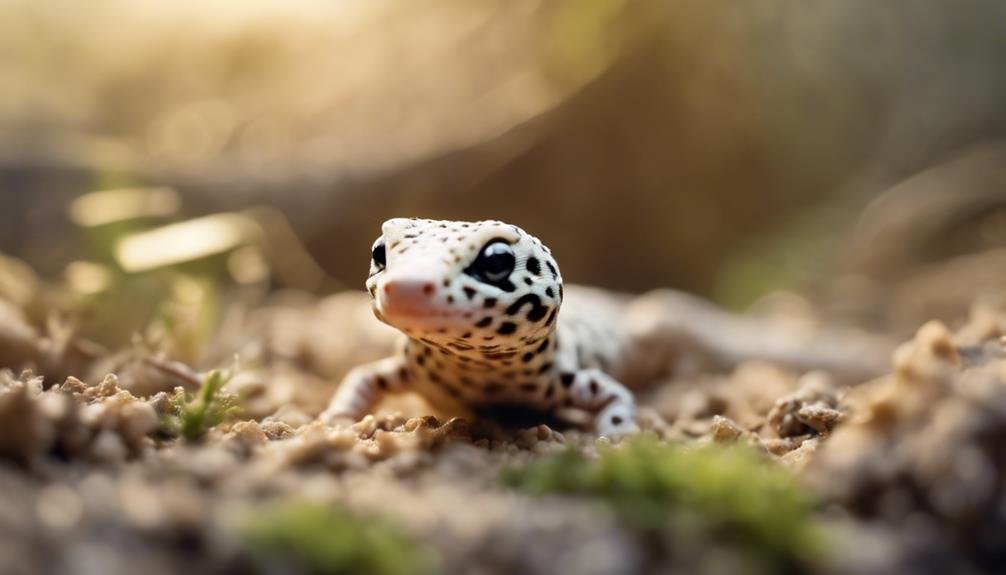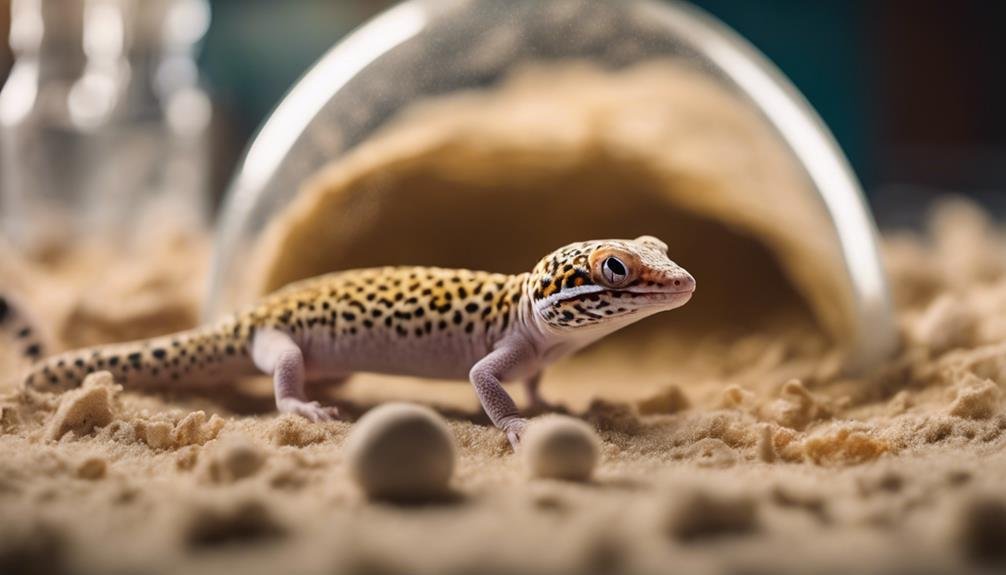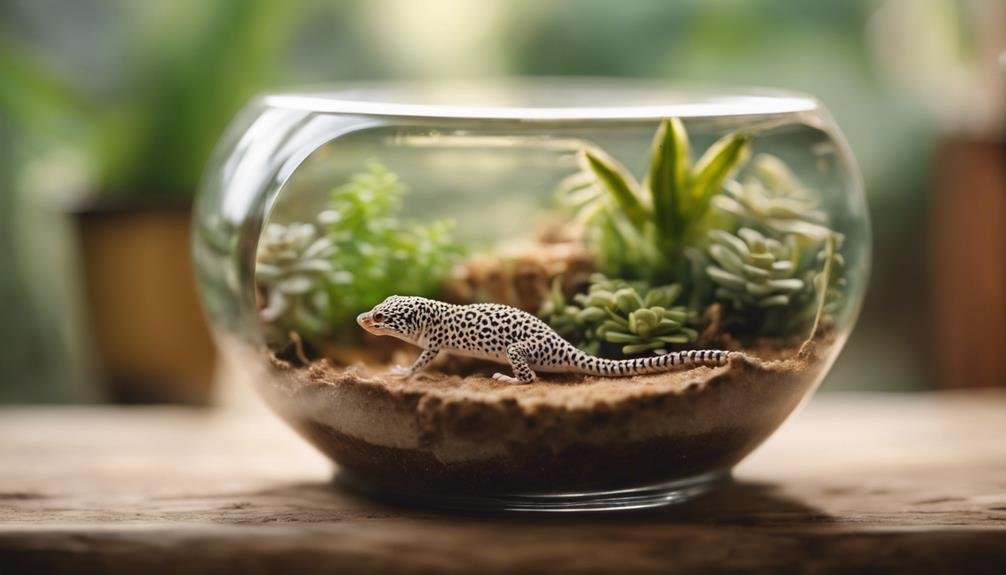You've probably heard that Eco Earth is a go-to substrate for leopard geckos, praised for its natural feel and moisture-retaining properties. It's true, this substrate can offer your gecko a more engaging habitat, encouraging essential behaviors like digging. However, you might also be aware of the debates surrounding its dustiness and the risk of accidental ingestion. As you weigh the benefits against the potential hazards, consider how a balanced approach to your gecko's environment, incorporating safety measures and habitat enrichment, could provide the best of both worlds. What factors should you prioritize to guarantee the well-being of your leopard gecko?
Key Takeaways
- Eco Earth mimics leopard geckos' natural habitat, encouraging digging and natural behaviors.
- It provides effective humidity control, essential for leopard geckos' health.
- The substrate's dustiness when dry can pose inhalation risks and respiratory health concerns.
- There's a potential risk of impaction if the substrate is ingested by the geckos.
- Despite risks, it's cost-effective, easy to clean, and offers an engaging environment.
Understanding Eco Earth
Eco Earth, a coconut fiber substrate, offers a safe and naturalistic environment for leopard geckos, combining affordability with effective humidity control. This substrate stands out for its ability to mimic the natural habitat of your leopard gecko, providing not only a visually appealing setup but also a functional one that supports their well-being.
However, as you explore using Eco Earth, you'll need to weigh a few concerns. Its dustiness when dry can be a point of contention. You're aiming for a habitat that's important and safe for your leopard gecko, so monitoring the substrate's moisture level is significant to prevent it from becoming too dusty, which could irritate their respiratory system. Another aspect to take into account is how loose the substrate can become if not maintained properly. This requires regular check-ins to make sure the enclosure remains a stable and secure environment.
While some keepers might lean towards sand-based mixes due to personal preference or past experience, Eco Earth presents itself as a viable, if not superior, alternative. Its naturalistic appeal, coupled with the safety it offers if ingested, makes it a popular choice. Yet, success with this substrate hinges on mindful maintenance and a commitment to creating the most conducive habitat for your leopard gecko.
Benefits for Leopard Geckos
Understanding the concerns surrounding Eco Earth, let's now explore how it directly benefits leopard geckos in their enclosures. Eco Earth stands out as a substrate that encourages your leopard gecko to dig and exhibit their natural behaviors, creating a more engaging and enriching environment. This not only keeps them physically active but also mentally stimulated.
Moreover, Eco Earth offers a natural look and feel to your gecko's habitat, making it not just a living space but a piece of their natural world recreated. Its cost-effectiveness, durability, and ease of cleaning make it an appealing choice for many pet owners. You'll find it's not only light on your wallet but also simple to maintain over time.
One of the key benefits of Eco Earth is its capacity for efficient humidity control, which is important for creating a comfortable environment for your leopard gecko. It enables the creation of a humid hide, essential for their well-being, especially during shedding. Plus, should your pet ingest some of this substrate, it's designed to pass harmlessly through their digestive system, alleviating concerns over potential internal blockages. Eco Earth, therefore, supports not just the physical health of your leopard gecko but also contributes positively to their overall living conditions.
Potential Risks


While Eco Earth offers numerous benefits for leopard geckos, it's important to take into account the potential risks associated with its use in their enclosures. One significant concern is when Eco Earth becomes dusty and loose after completely drying out. This condition can pose inhalation risks to your leopard gecko, which might affect its respiratory health. In addition, the ingestion of dry Eco Earth may lead to impaction, a severe health issue that could threaten your gecko's well-being. As the substrate compacts inside the digestive tract, it can block the normal passage of food, leading to potentially fatal consequences.
Another point of contention among keepers revolves around Eco Earth's humidity traits. While maintaining proper humidity is essential for a leopard gecko's health, the substrate's ability to hold moisture can sometimes complicate achieving the right tank conditions. It's a delicate balance; too much humidity can foster an environment where harmful bacteria thrive, while too little can exacerbate the dustiness of Eco Earth, increasing the risk of respiratory issues. Being mindful of these potential risks, including dustiness and the challenge of humidity control, is important in ensuring the health and safety of your leopard gecko when using Eco Earth as a substrate.
Optimal Habitat Conditions
Acknowledging the potential risks of using Eco Earth, it's equally important to focus on creating the ideal habitat conditions for your leopard gecko. Providing the right environment is vital for their health and well-being. Here's how you can guarantee your pet thrives:
- Temperature: Maintain a gradient from 88-92°F on the warm side to 70-75°F on the cool side.
- Humidity: Keep humidity levels at 30-40%, increasing to about 60% during shedding periods.
- UVB Light: Install a proper UVB light source to aid in calcium absorption and overall health.
- Hiding Spots: Ensure there are adequate hiding spots on both the warm and cool sides of the tank.
These elements are key to mimicking a leopard gecko's natural environment as closely as possible. Remember, the choice of substrates and bedding plays a significant role in managing humidity and temperature within the enclosure. Additionally, a tank size of at least 10 gallons per gecko is essential for allowing proper movement and exhibiting natural behaviors. By focusing on these habitat conditions, you'll create a safe and comfortable space for your leopard gecko to thrive, beyond just the selection of substrates and bedding.
Alternatives to Eco Earth


Exploring alternatives to Eco Earth for leopard geckos is crucial in guaranteeing their habitat remains safe and comfortable. If you're looking for substrate alternatives that minimize health risks and maintain a clean environment for your pet, consider several options.
Duck Brand Shelf Liner, specifically the non-perforated type, serves as a smooth, easy-to-clean surface, much like tiles. It's a practical choice, offering a balance between safety and simplicity in maintenance.
However, not all alternatives come without their challenges. Sand mats, while aesthetically pleasing, can be difficult to clean and may pose health risks if sand particles detach and are ingested by your gecko. Similarly, reptile carpet requires diligent cleaning to prevent buildup of waste and can cause injuries to your gecko's toes and mouth if not maintained properly.
For those seeking the most hassle-free option, paper towels stand out. They're easily replaceable and ensure a sanitary environment for your gecko. Finally, switching to tiles is highly recommended for a long-term substrate solution. Tiles are durable, easy to clean, and eliminate many of the health risks associated with looser substrates.
Is Eco Earth a Suitable Substrate for Leopard Geckos?
Yes, Eco Earth is a suitable substrate for leopard geckos. This loose coconut fiber bedding provides excellent moisture retention and burrowing opportunities for these reptiles. As a natural and digestible option, eco earth leopard geckos substrate supports their natural behavior and overall well-being.
Frequently Asked Questions
What Is the Best Substrate for Leopard Geckos?
The best substrate for leopard geckos balances temperature regulation, humidity control, and cleaning ease while minimizing health risks. Consider cost comparison too.
Sand-based mixes, ideally with soil or clay, offer good substrate depth and help manage odors. Leo Life substrate emerges as a superior alternative, providing an ideal environment.
It's important to pick a substrate that supports your gecko's well-being, steering clear from options that could lead to impaction or other health issues.
What Bedding Should I Use for a Leopard Gecko Tank?
You should opt for bedding that promotes temperature regulation, humidity control, and is easy to clean for your leopard gecko tank.
Choose materials that help manage odors, offer dietary enrichment, and encourage your gecko's natural activities.
It's essential to select bedding that aids in health monitoring, ensuring your pet remains healthy and happy.
Options like a sand-clay mix or quality, sterilized soil can be great choices, aligning with these needs.
What Is the Best Moist Hide Substrate for Leopard Geckos?
For your leopard gecko's moist hide, the best substrate blends moisture retention and humidity control. You'll want to mix sphagnum moss with safe materials like coconut fiber or peat moss, possibly adding a vermiculite mix. This combo guarantees the hide stays humid, aiding in shedding and hydration without risking your gecko's health.
It's all about creating a comfy, safe spot that mimics their natural environment, keeping them happy and healthy.
What Is the Bioactive Substrate Mix for Leopard Geckos?
For your leopard gecko, a bioactive substrate mix is key. It's made of soil, sand, and clay, mimicking their natural habitat. This mix supports microfauna, essential for waste breakdown and a healthy tank.
Add live plants for a more naturalistic design. Remember, maintaining the right temperature and humidity, along with regular upkeep, is vital.
This setup not only promotes bioactive benefits but also guarantees your gecko thrives in a dynamic environment.
Conclusion
To sum up, you'll find Eco Earth to be a great choice for your leopard gecko's substrate. It not only mimics their natural habitat but also supports their digging behaviors, making their environment more enriching.
While there are risks like dustiness and possible ingestion, you can minimize these with proper care. Make sure their habitat also includes temperature gradients, hiding spots, and UVB light for best health.
If Eco Earth doesn't suit your needs, plenty of alternatives exist to explore.


